Financial Analysis: Cash Flow and Ratio Comparison of Companies
VerifiedAdded on 2023/06/04
|17
|3108
|139
Report
AI Summary
This report provides a detailed analysis of corporate accounting principles, focusing on cash flow statements and financial ratio comparisons across three major companies: Rio Tinto, Woolworths Limited, and Telstra Corporation. The analysis includes a comparison of cash flows from operating, investing, and financing activities, highlighting the differences between direct and indirect methods of presentation. Key financial ratios such as cash return, quality of earnings, solvency, and capital expenditure commitment are calculated and compared to assess the financial health and performance of each company. The report also examines Telstra Corporation's annual report, contrasting its ratio calculations with those emphasized in academic literature, and concludes with a discussion of Telstra's board of directors and overall financial performance, offering insights into its profitability, equity growth, and future prospects. Desklib offers this and many other solved assignments for students.
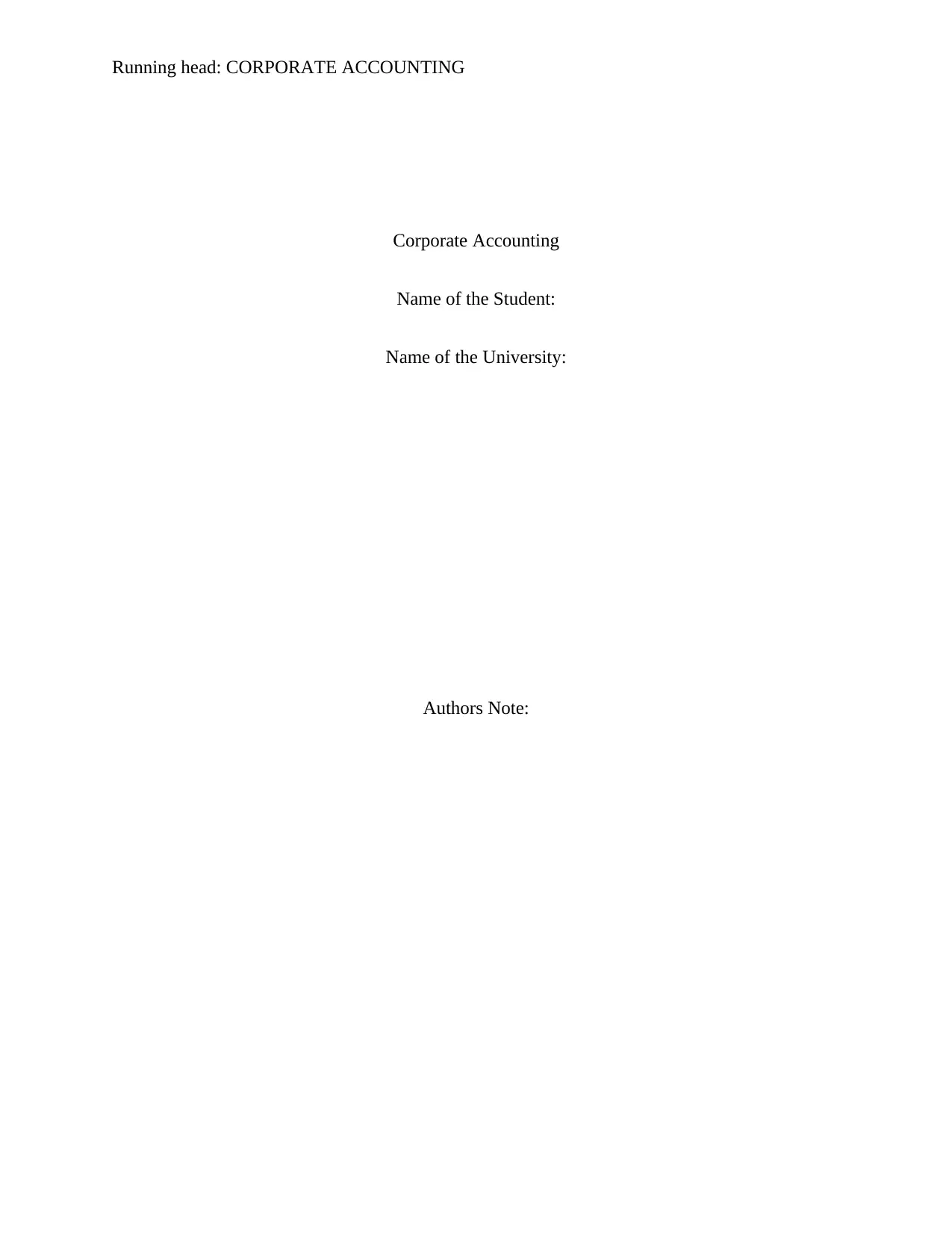
Running head: CORPORATE ACCOUNTING
Corporate Accounting
Name of the Student:
Name of the University:
Authors Note:
Corporate Accounting
Name of the Student:
Name of the University:
Authors Note:
Paraphrase This Document
Need a fresh take? Get an instant paraphrase of this document with our AI Paraphraser
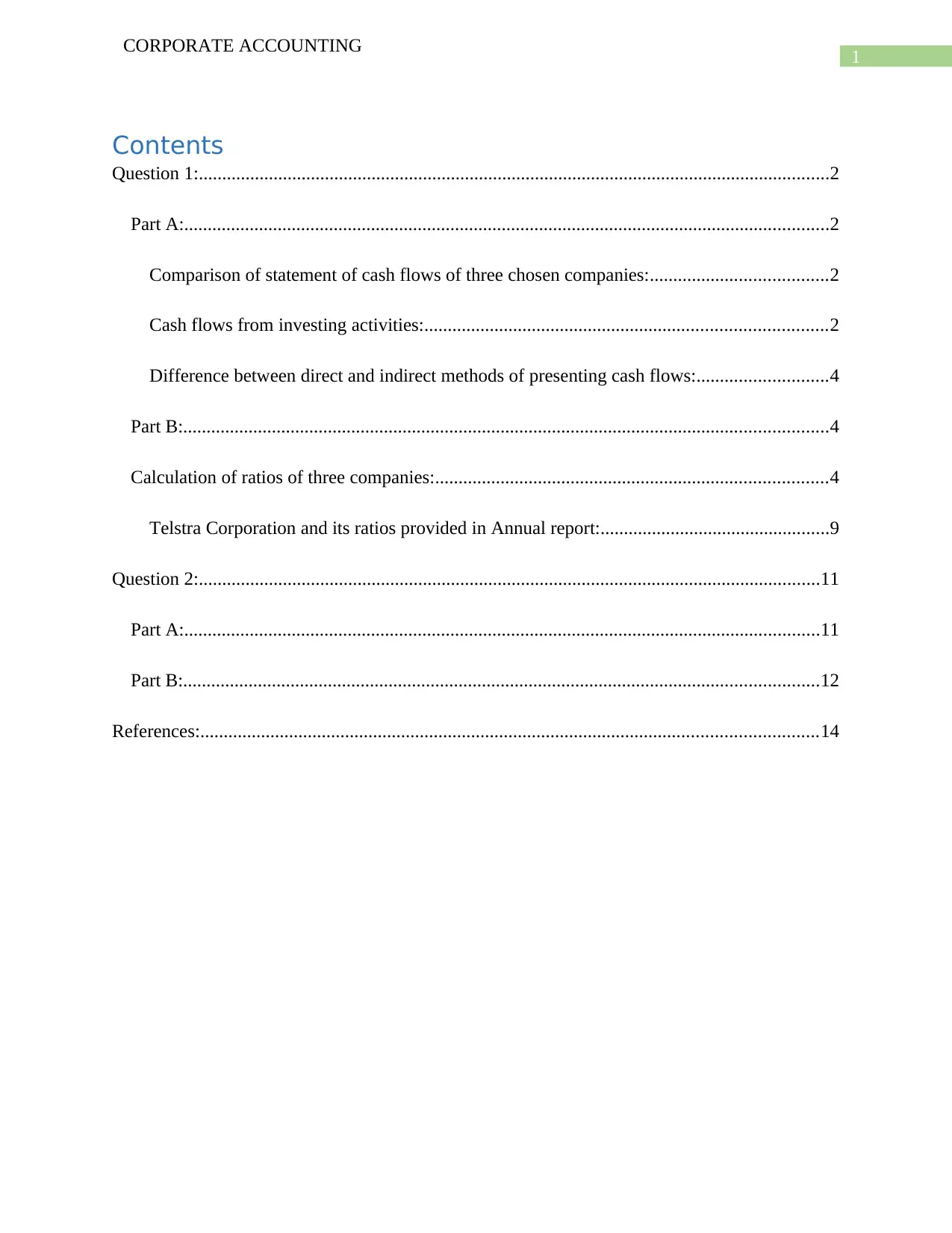
1
CORPORATE ACCOUNTING
Contents
Question 1:.......................................................................................................................................2
Part A:..........................................................................................................................................2
Comparison of statement of cash flows of three chosen companies:......................................2
Cash flows from investing activities:......................................................................................2
Difference between direct and indirect methods of presenting cash flows:............................4
Part B:..........................................................................................................................................4
Calculation of ratios of three companies:....................................................................................4
Telstra Corporation and its ratios provided in Annual report:.................................................9
Question 2:.....................................................................................................................................11
Part A:........................................................................................................................................11
Part B:........................................................................................................................................12
References:....................................................................................................................................14
CORPORATE ACCOUNTING
Contents
Question 1:.......................................................................................................................................2
Part A:..........................................................................................................................................2
Comparison of statement of cash flows of three chosen companies:......................................2
Cash flows from investing activities:......................................................................................2
Difference between direct and indirect methods of presenting cash flows:............................4
Part B:..........................................................................................................................................4
Calculation of ratios of three companies:....................................................................................4
Telstra Corporation and its ratios provided in Annual report:.................................................9
Question 2:.....................................................................................................................................11
Part A:........................................................................................................................................11
Part B:........................................................................................................................................12
References:....................................................................................................................................14

2
CORPORATE ACCOUNTING
Question 1:
Part A:
Comparison of statement of cash flows of three chosen companies:
Cash flows from operating activities:
In case of Rio Tinto the major category of cash flows in operating activities include cash from
consolidated operations, dividend received from equity accounted units, interest payment,
dividend paid to holders of non-controlling interests and payment of tax. In 2017 the company
collected cash of $16,670 million from consolidated operations and received dividend from
equity accounted units of $817 million. Net interest paid is $897 million with payment of
dividend to holders of non-controlling interests of $399 million. The company also paid tax of
$2,307 million in 2017 (Gordon et. al. 2017).
Woolworths Group on the other hand reported cash receipts of $65,498.9 million from customers
along with payment of $61,474.8 million to suppliers and employees of the company in 2017.
$234 million and $668.1 million were paid as interest and taxes respectively also reported under
operating activities of the company (Penman and Yehuda, 2015).
In 2017 Telstra reported $7,775 million as net cash generated from operating activities. The
operating activities cash inflows and outflows for the company include receipts of $31,288 from
customers; payment of $21,997 million to the suppliers and employees of the company; revenue
grants received by the company is $235 million and income tax paid $1,751 million.
CORPORATE ACCOUNTING
Question 1:
Part A:
Comparison of statement of cash flows of three chosen companies:
Cash flows from operating activities:
In case of Rio Tinto the major category of cash flows in operating activities include cash from
consolidated operations, dividend received from equity accounted units, interest payment,
dividend paid to holders of non-controlling interests and payment of tax. In 2017 the company
collected cash of $16,670 million from consolidated operations and received dividend from
equity accounted units of $817 million. Net interest paid is $897 million with payment of
dividend to holders of non-controlling interests of $399 million. The company also paid tax of
$2,307 million in 2017 (Gordon et. al. 2017).
Woolworths Group on the other hand reported cash receipts of $65,498.9 million from customers
along with payment of $61,474.8 million to suppliers and employees of the company in 2017.
$234 million and $668.1 million were paid as interest and taxes respectively also reported under
operating activities of the company (Penman and Yehuda, 2015).
In 2017 Telstra reported $7,775 million as net cash generated from operating activities. The
operating activities cash inflows and outflows for the company include receipts of $31,288 from
customers; payment of $21,997 million to the suppliers and employees of the company; revenue
grants received by the company is $235 million and income tax paid $1,751 million.
⊘ This is a preview!⊘
Do you want full access?
Subscribe today to unlock all pages.

Trusted by 1+ million students worldwide
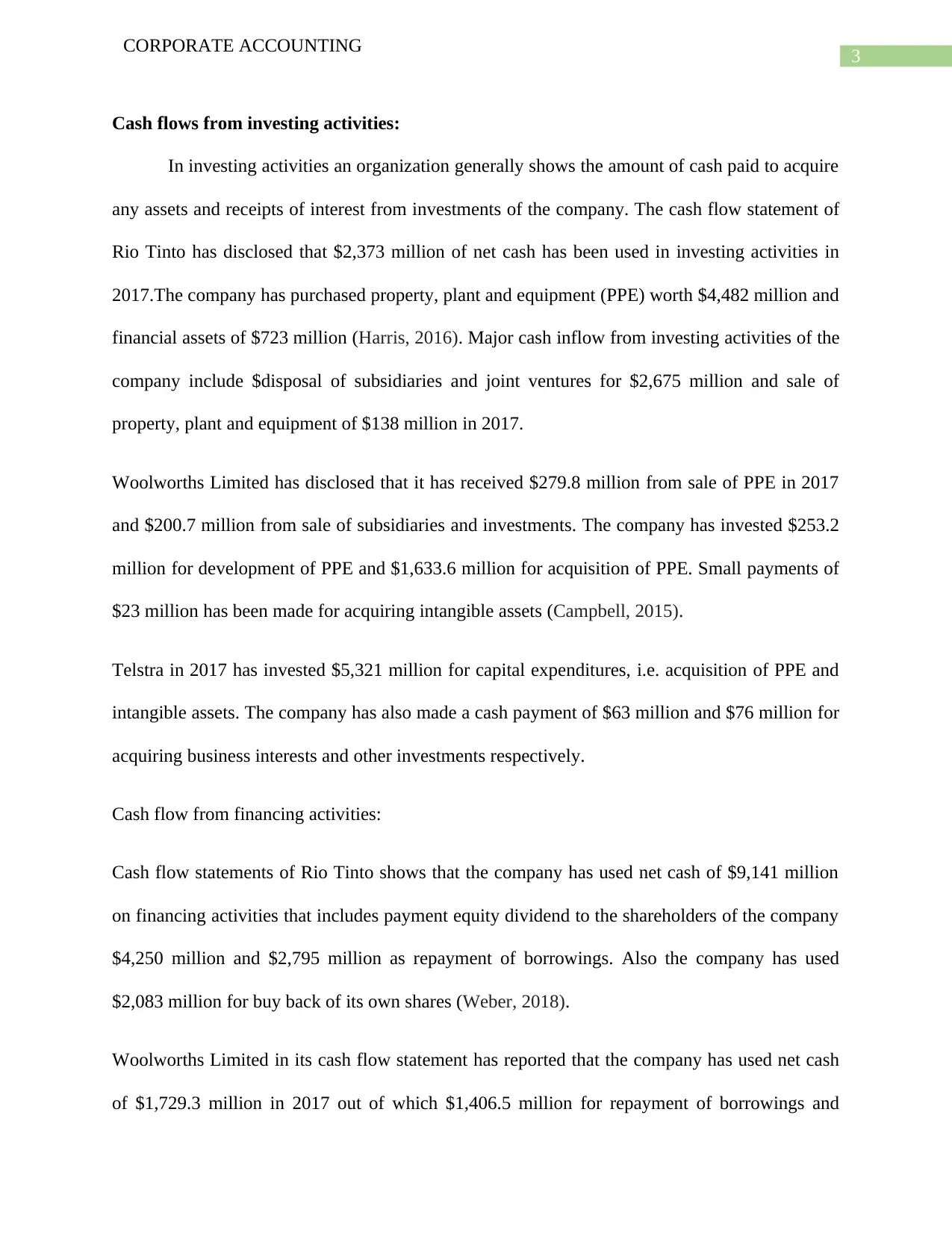
3
CORPORATE ACCOUNTING
Cash flows from investing activities:
In investing activities an organization generally shows the amount of cash paid to acquire
any assets and receipts of interest from investments of the company. The cash flow statement of
Rio Tinto has disclosed that $2,373 million of net cash has been used in investing activities in
2017.The company has purchased property, plant and equipment (PPE) worth $4,482 million and
financial assets of $723 million (Harris, 2016). Major cash inflow from investing activities of the
company include $disposal of subsidiaries and joint ventures for $2,675 million and sale of
property, plant and equipment of $138 million in 2017.
Woolworths Limited has disclosed that it has received $279.8 million from sale of PPE in 2017
and $200.7 million from sale of subsidiaries and investments. The company has invested $253.2
million for development of PPE and $1,633.6 million for acquisition of PPE. Small payments of
$23 million has been made for acquiring intangible assets (Campbell, 2015).
Telstra in 2017 has invested $5,321 million for capital expenditures, i.e. acquisition of PPE and
intangible assets. The company has also made a cash payment of $63 million and $76 million for
acquiring business interests and other investments respectively.
Cash flow from financing activities:
Cash flow statements of Rio Tinto shows that the company has used net cash of $9,141 million
on financing activities that includes payment equity dividend to the shareholders of the company
$4,250 million and $2,795 million as repayment of borrowings. Also the company has used
$2,083 million for buy back of its own shares (Weber, 2018).
Woolworths Limited in its cash flow statement has reported that the company has used net cash
of $1,729.3 million in 2017 out of which $1,406.5 million for repayment of borrowings and
CORPORATE ACCOUNTING
Cash flows from investing activities:
In investing activities an organization generally shows the amount of cash paid to acquire
any assets and receipts of interest from investments of the company. The cash flow statement of
Rio Tinto has disclosed that $2,373 million of net cash has been used in investing activities in
2017.The company has purchased property, plant and equipment (PPE) worth $4,482 million and
financial assets of $723 million (Harris, 2016). Major cash inflow from investing activities of the
company include $disposal of subsidiaries and joint ventures for $2,675 million and sale of
property, plant and equipment of $138 million in 2017.
Woolworths Limited has disclosed that it has received $279.8 million from sale of PPE in 2017
and $200.7 million from sale of subsidiaries and investments. The company has invested $253.2
million for development of PPE and $1,633.6 million for acquisition of PPE. Small payments of
$23 million has been made for acquiring intangible assets (Campbell, 2015).
Telstra in 2017 has invested $5,321 million for capital expenditures, i.e. acquisition of PPE and
intangible assets. The company has also made a cash payment of $63 million and $76 million for
acquiring business interests and other investments respectively.
Cash flow from financing activities:
Cash flow statements of Rio Tinto shows that the company has used net cash of $9,141 million
on financing activities that includes payment equity dividend to the shareholders of the company
$4,250 million and $2,795 million as repayment of borrowings. Also the company has used
$2,083 million for buy back of its own shares (Weber, 2018).
Woolworths Limited in its cash flow statement has reported that the company has used net cash
of $1,729.3 million in 2017 out of which $1,406.5 million for repayment of borrowings and
Paraphrase This Document
Need a fresh take? Get an instant paraphrase of this document with our AI Paraphraser
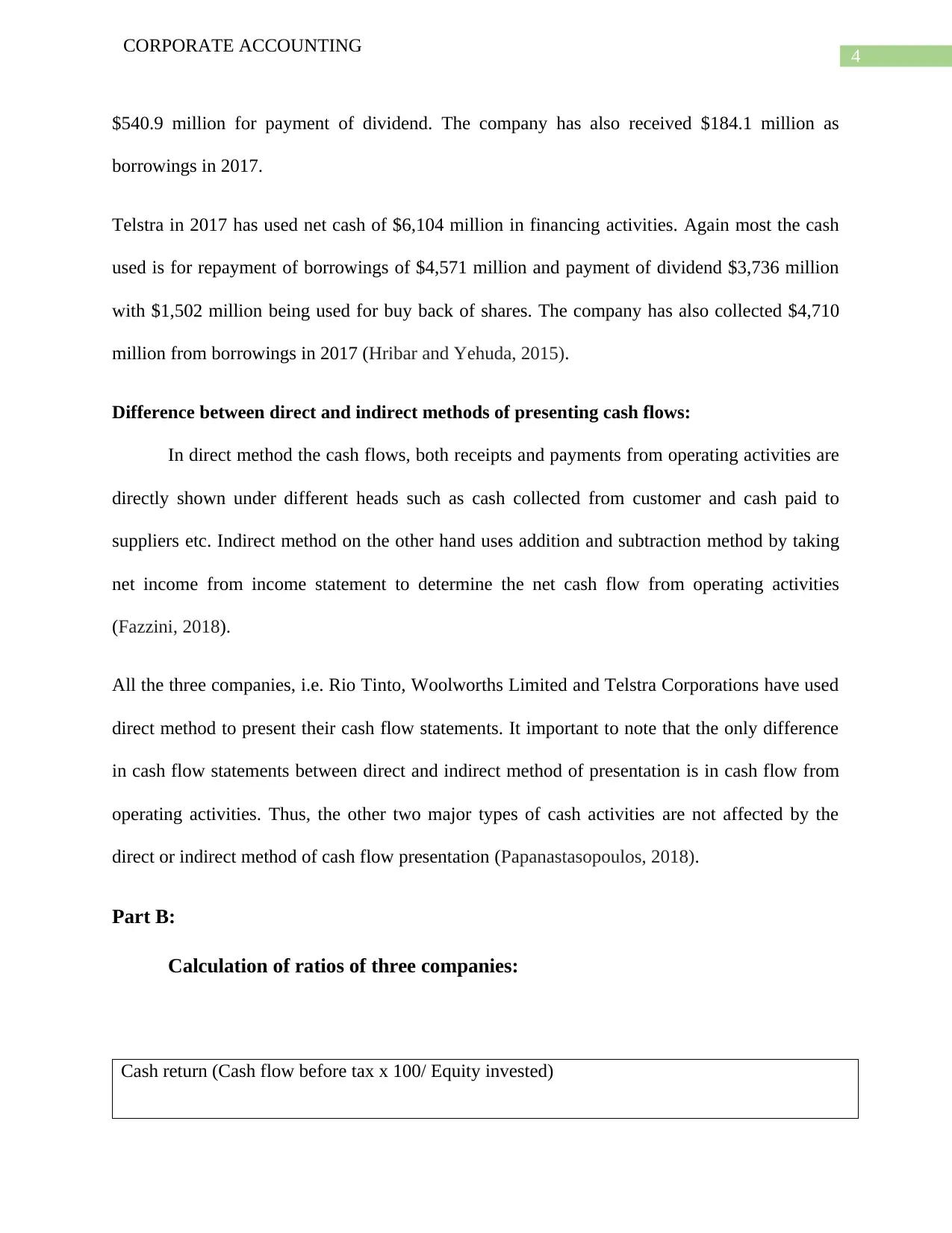
4
CORPORATE ACCOUNTING
$540.9 million for payment of dividend. The company has also received $184.1 million as
borrowings in 2017.
Telstra in 2017 has used net cash of $6,104 million in financing activities. Again most the cash
used is for repayment of borrowings of $4,571 million and payment of dividend $3,736 million
with $1,502 million being used for buy back of shares. The company has also collected $4,710
million from borrowings in 2017 (Hribar and Yehuda, 2015).
Difference between direct and indirect methods of presenting cash flows:
In direct method the cash flows, both receipts and payments from operating activities are
directly shown under different heads such as cash collected from customer and cash paid to
suppliers etc. Indirect method on the other hand uses addition and subtraction method by taking
net income from income statement to determine the net cash flow from operating activities
(Fazzini, 2018).
All the three companies, i.e. Rio Tinto, Woolworths Limited and Telstra Corporations have used
direct method to present their cash flow statements. It important to note that the only difference
in cash flow statements between direct and indirect method of presentation is in cash flow from
operating activities. Thus, the other two major types of cash activities are not affected by the
direct or indirect method of cash flow presentation (Papanastasopoulos, 2018).
Part B:
Calculation of ratios of three companies:
Cash return (Cash flow before tax x 100/ Equity invested)
CORPORATE ACCOUNTING
$540.9 million for payment of dividend. The company has also received $184.1 million as
borrowings in 2017.
Telstra in 2017 has used net cash of $6,104 million in financing activities. Again most the cash
used is for repayment of borrowings of $4,571 million and payment of dividend $3,736 million
with $1,502 million being used for buy back of shares. The company has also collected $4,710
million from borrowings in 2017 (Hribar and Yehuda, 2015).
Difference between direct and indirect methods of presenting cash flows:
In direct method the cash flows, both receipts and payments from operating activities are
directly shown under different heads such as cash collected from customer and cash paid to
suppliers etc. Indirect method on the other hand uses addition and subtraction method by taking
net income from income statement to determine the net cash flow from operating activities
(Fazzini, 2018).
All the three companies, i.e. Rio Tinto, Woolworths Limited and Telstra Corporations have used
direct method to present their cash flow statements. It important to note that the only difference
in cash flow statements between direct and indirect method of presentation is in cash flow from
operating activities. Thus, the other two major types of cash activities are not affected by the
direct or indirect method of cash flow presentation (Papanastasopoulos, 2018).
Part B:
Calculation of ratios of three companies:
Cash return (Cash flow before tax x 100/ Equity invested)
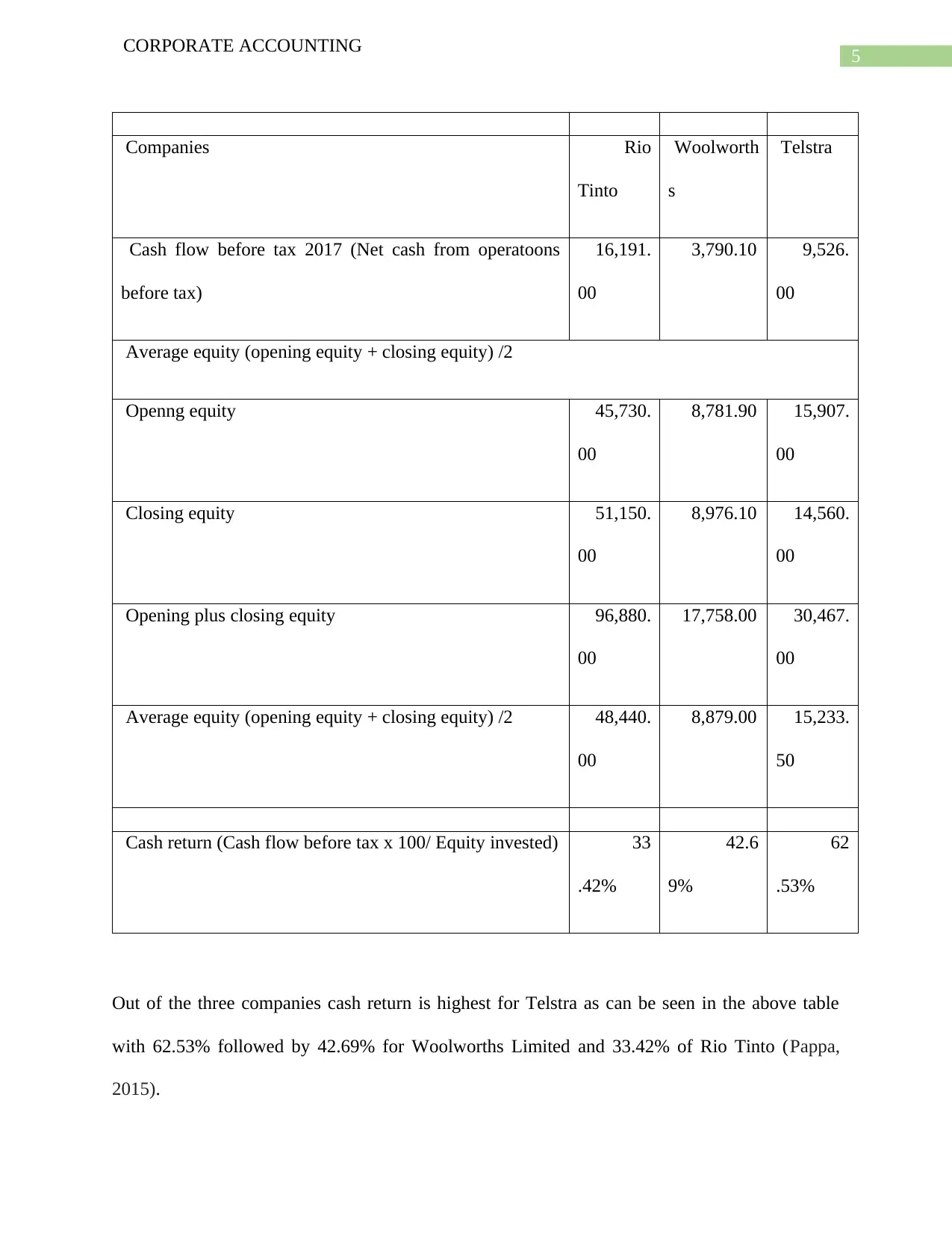
5
CORPORATE ACCOUNTING
Companies Rio
Tinto
Woolworth
s
Telstra
Cash flow before tax 2017 (Net cash from operatoons
before tax)
16,191.
00
3,790.10 9,526.
00
Average equity (opening equity + closing equity) /2
Openng equity 45,730.
00
8,781.90 15,907.
00
Closing equity 51,150.
00
8,976.10 14,560.
00
Opening plus closing equity 96,880.
00
17,758.00 30,467.
00
Average equity (opening equity + closing equity) /2 48,440.
00
8,879.00 15,233.
50
Cash return (Cash flow before tax x 100/ Equity invested) 33
.42%
42.6
9%
62
.53%
Out of the three companies cash return is highest for Telstra as can be seen in the above table
with 62.53% followed by 42.69% for Woolworths Limited and 33.42% of Rio Tinto (Pappa,
2015).
CORPORATE ACCOUNTING
Companies Rio
Tinto
Woolworth
s
Telstra
Cash flow before tax 2017 (Net cash from operatoons
before tax)
16,191.
00
3,790.10 9,526.
00
Average equity (opening equity + closing equity) /2
Openng equity 45,730.
00
8,781.90 15,907.
00
Closing equity 51,150.
00
8,976.10 14,560.
00
Opening plus closing equity 96,880.
00
17,758.00 30,467.
00
Average equity (opening equity + closing equity) /2 48,440.
00
8,879.00 15,233.
50
Cash return (Cash flow before tax x 100/ Equity invested) 33
.42%
42.6
9%
62
.53%
Out of the three companies cash return is highest for Telstra as can be seen in the above table
with 62.53% followed by 42.69% for Woolworths Limited and 33.42% of Rio Tinto (Pappa,
2015).
⊘ This is a preview!⊘
Do you want full access?
Subscribe today to unlock all pages.

Trusted by 1+ million students worldwide

6
CORPORATE ACCOUNTING
Quality of earnings ratio:
Quality of earnings ratio (Cash flow from operations / Net income)
Companies Rio
Tinto
Woolwort
hs
Telstra
Cash flow from operations 13,884.
00
3,122.00 9,52
6.00
Net income 8,851.
00
1,482.00 3,87
4.00
Quality of earnings ratio (Cash flow from operations /
Net income) Times
1
.57
2.1
1 2.46
As can be seen in the table above that the quality of earnings of Telstra is 2.46 times which is by
far the most out of three selected companies. Woolworths Limited’s quality of earnings ratio
with 2.11 times is also very good. Rio Tinto has 1.57 times of quality of earnings ratio which is
also quite good as anything greater than 1 for the ratio is considered good for an organization
(Dalnial et. al. 2014).
Solvency ratios:
Solvency ratio {(net income + Depreciation) / all liabilities}
Companies Rio Woolworth Telstra
CORPORATE ACCOUNTING
Quality of earnings ratio:
Quality of earnings ratio (Cash flow from operations / Net income)
Companies Rio
Tinto
Woolwort
hs
Telstra
Cash flow from operations 13,884.
00
3,122.00 9,52
6.00
Net income 8,851.
00
1,482.00 3,87
4.00
Quality of earnings ratio (Cash flow from operations /
Net income) Times
1
.57
2.1
1 2.46
As can be seen in the table above that the quality of earnings of Telstra is 2.46 times which is by
far the most out of three selected companies. Woolworths Limited’s quality of earnings ratio
with 2.11 times is also very good. Rio Tinto has 1.57 times of quality of earnings ratio which is
also quite good as anything greater than 1 for the ratio is considered good for an organization
(Dalnial et. al. 2014).
Solvency ratios:
Solvency ratio {(net income + Depreciation) / all liabilities}
Companies Rio Woolworth Telstra
Paraphrase This Document
Need a fresh take? Get an instant paraphrase of this document with our AI Paraphraser

7
CORPORATE ACCOUNTING
Tinto s
Net income 8,851.
00
1,482.00 3,874.
00
Add: Depreciation 4,375.
00
1,037.60 4,441.
00
13,226.
00
2,519.60 8,315.
00
All liabilities 44,611.
00
13,039.70 27,573.
00
Solvency ratio {(net income + Depreciation) / all
liabilities}
29.
65%
19.3
2%
30.
16%
Again Telstra has highest solvency ratio with 30.16% followed by 29.65% of Rio Tinto and
19.32% of Woolworths Limited. It is clear that the ability of Telstra to discharge its obligations
is better than other two companies (Phillips, 2016).
Capital expenditure commitment:
Capital expenditure commitment (cash flow from operations / Capital expenditures)
Companies Rio Woolwort Telstra
CORPORATE ACCOUNTING
Tinto s
Net income 8,851.
00
1,482.00 3,874.
00
Add: Depreciation 4,375.
00
1,037.60 4,441.
00
13,226.
00
2,519.60 8,315.
00
All liabilities 44,611.
00
13,039.70 27,573.
00
Solvency ratio {(net income + Depreciation) / all
liabilities}
29.
65%
19.3
2%
30.
16%
Again Telstra has highest solvency ratio with 30.16% followed by 29.65% of Rio Tinto and
19.32% of Woolworths Limited. It is clear that the ability of Telstra to discharge its obligations
is better than other two companies (Phillips, 2016).
Capital expenditure commitment:
Capital expenditure commitment (cash flow from operations / Capital expenditures)
Companies Rio Woolwort Telstra

8
CORPORATE ACCOUNTING
Tinto hs
Cash flow from operations 13,884.
00
3,122.00 9,52
6.00
Capital expenditures:
Purchased of PPE 4,482.
00
1,886.80 3,72
5.00
Purchase of financial assets 723
.00
Purchase of intangible assets 23.0
0
1,59
6.00
Capital expenditures 5,205.
00
1,909.80 5,32
1.00
Capital expenditure commitment (cash flow from
operations / Capital expenditures) Times
2
.67
1.6
3 1.79
Capital expenditure commitment of Rio Tinto with 2.67 times is highest out of the three
companies selected suggest that the ability of Rio Tinto to discharge its capital obligation.
Telstra Corporation has a capital commitment expenditure of 1.79 times followed by
Woolworths Limited of 1.63 times (Kaur, Aggarwal and Gupta, 2017).
CORPORATE ACCOUNTING
Tinto hs
Cash flow from operations 13,884.
00
3,122.00 9,52
6.00
Capital expenditures:
Purchased of PPE 4,482.
00
1,886.80 3,72
5.00
Purchase of financial assets 723
.00
Purchase of intangible assets 23.0
0
1,59
6.00
Capital expenditures 5,205.
00
1,909.80 5,32
1.00
Capital expenditure commitment (cash flow from
operations / Capital expenditures) Times
2
.67
1.6
3 1.79
Capital expenditure commitment of Rio Tinto with 2.67 times is highest out of the three
companies selected suggest that the ability of Rio Tinto to discharge its capital obligation.
Telstra Corporation has a capital commitment expenditure of 1.79 times followed by
Woolworths Limited of 1.63 times (Kaur, Aggarwal and Gupta, 2017).
⊘ This is a preview!⊘
Do you want full access?
Subscribe today to unlock all pages.

Trusted by 1+ million students worldwide
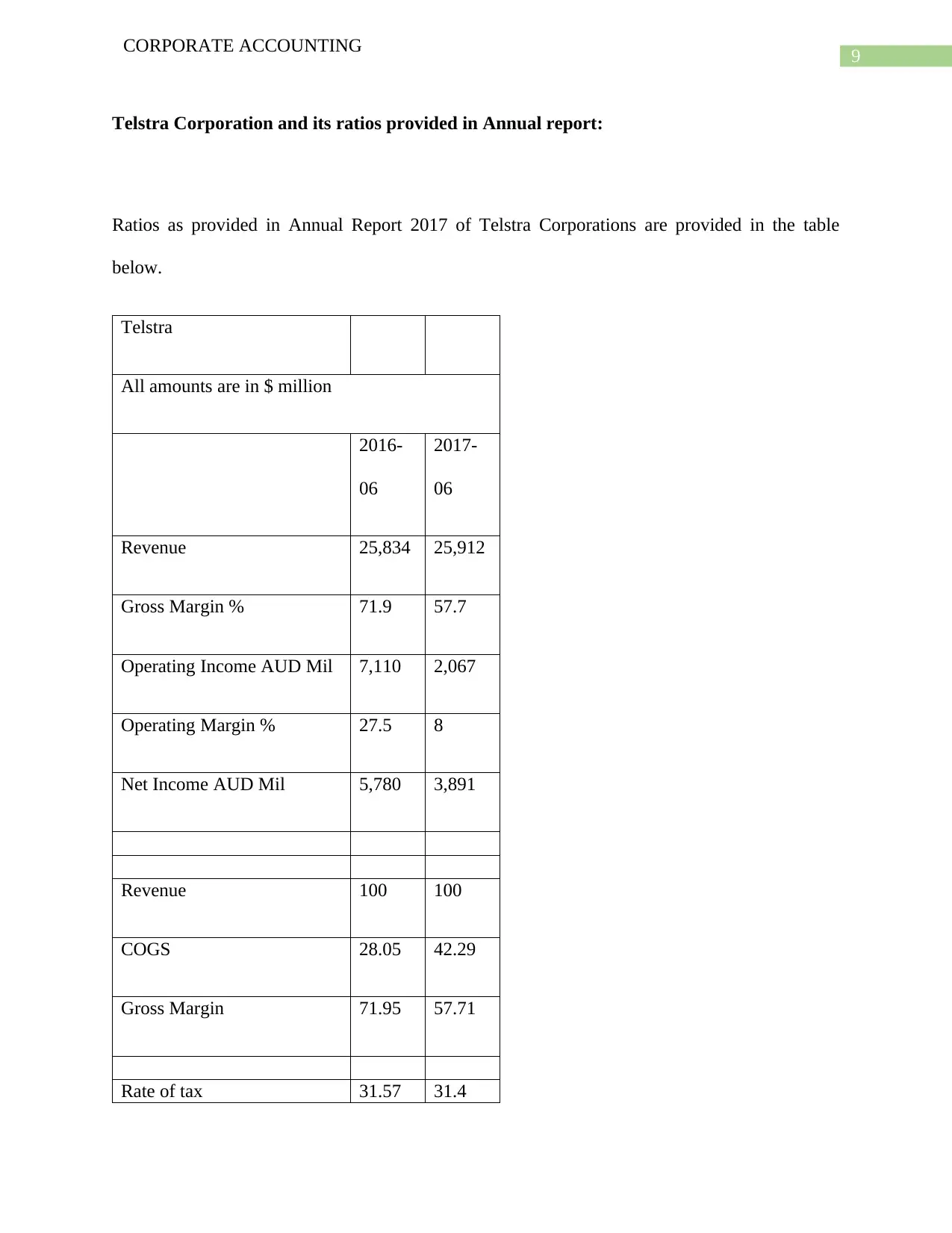
9
CORPORATE ACCOUNTING
Telstra Corporation and its ratios provided in Annual report:
Ratios as provided in Annual Report 2017 of Telstra Corporations are provided in the table
below.
Telstra
All amounts are in $ million
2016-
06
2017-
06
Revenue 25,834 25,912
Gross Margin % 71.9 57.7
Operating Income AUD Mil 7,110 2,067
Operating Margin % 27.5 8
Net Income AUD Mil 5,780 3,891
Revenue 100 100
COGS 28.05 42.29
Gross Margin 71.95 57.71
Rate of tax 31.57 31.4
CORPORATE ACCOUNTING
Telstra Corporation and its ratios provided in Annual report:
Ratios as provided in Annual Report 2017 of Telstra Corporations are provided in the table
below.
Telstra
All amounts are in $ million
2016-
06
2017-
06
Revenue 25,834 25,912
Gross Margin % 71.9 57.7
Operating Income AUD Mil 7,110 2,067
Operating Margin % 27.5 8
Net Income AUD Mil 5,780 3,891
Revenue 100 100
COGS 28.05 42.29
Gross Margin 71.95 57.71
Rate of tax 31.57 31.4
Paraphrase This Document
Need a fresh take? Get an instant paraphrase of this document with our AI Paraphraser
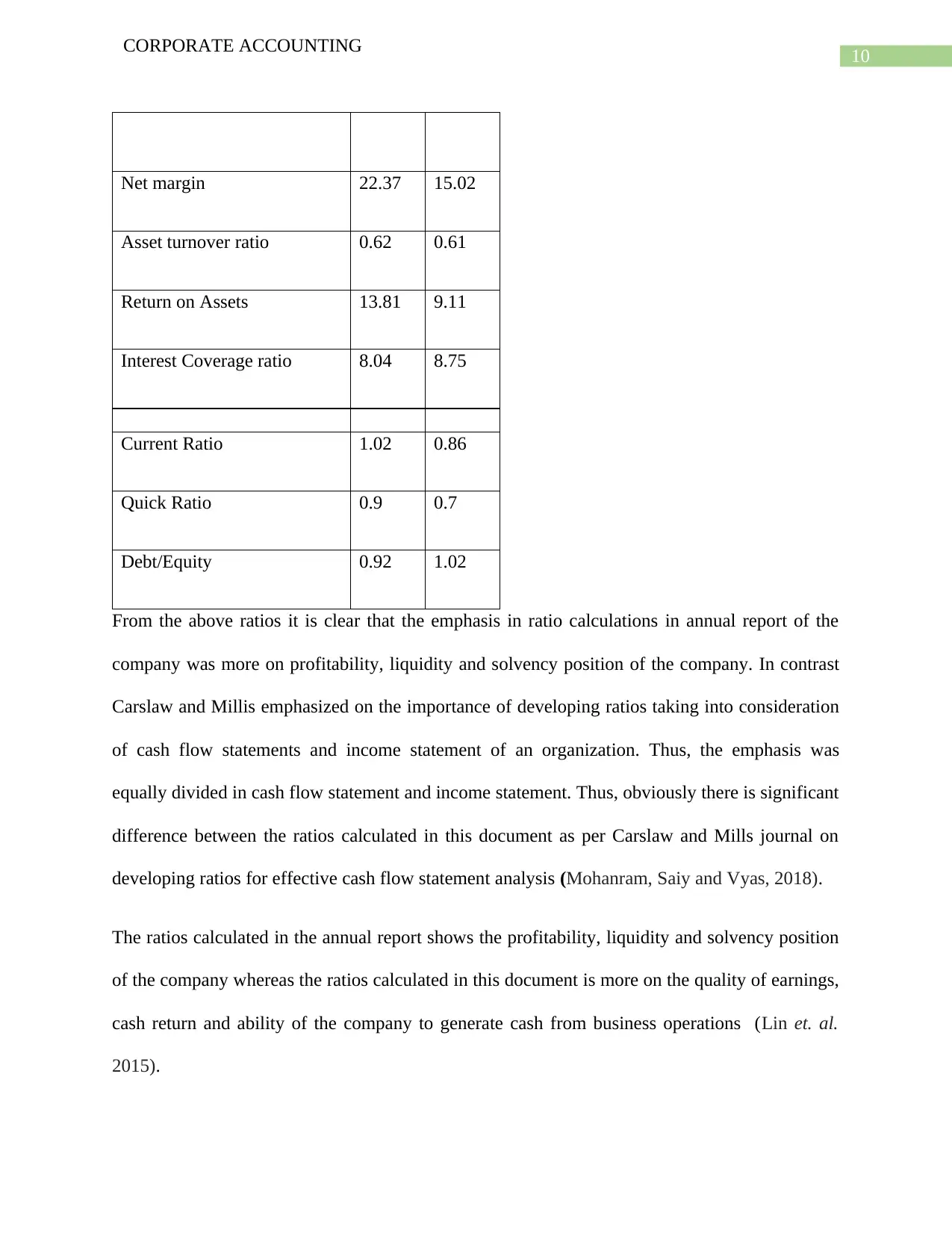
10
CORPORATE ACCOUNTING
Net margin 22.37 15.02
Asset turnover ratio 0.62 0.61
Return on Assets 13.81 9.11
Interest Coverage ratio 8.04 8.75
Current Ratio 1.02 0.86
Quick Ratio 0.9 0.7
Debt/Equity 0.92 1.02
From the above ratios it is clear that the emphasis in ratio calculations in annual report of the
company was more on profitability, liquidity and solvency position of the company. In contrast
Carslaw and Millis emphasized on the importance of developing ratios taking into consideration
of cash flow statements and income statement of an organization. Thus, the emphasis was
equally divided in cash flow statement and income statement. Thus, obviously there is significant
difference between the ratios calculated in this document as per Carslaw and Mills journal on
developing ratios for effective cash flow statement analysis (Mohanram, Saiy and Vyas, 2018).
The ratios calculated in the annual report shows the profitability, liquidity and solvency position
of the company whereas the ratios calculated in this document is more on the quality of earnings,
cash return and ability of the company to generate cash from business operations (Lin et. al.
2015).
CORPORATE ACCOUNTING
Net margin 22.37 15.02
Asset turnover ratio 0.62 0.61
Return on Assets 13.81 9.11
Interest Coverage ratio 8.04 8.75
Current Ratio 1.02 0.86
Quick Ratio 0.9 0.7
Debt/Equity 0.92 1.02
From the above ratios it is clear that the emphasis in ratio calculations in annual report of the
company was more on profitability, liquidity and solvency position of the company. In contrast
Carslaw and Millis emphasized on the importance of developing ratios taking into consideration
of cash flow statements and income statement of an organization. Thus, the emphasis was
equally divided in cash flow statement and income statement. Thus, obviously there is significant
difference between the ratios calculated in this document as per Carslaw and Mills journal on
developing ratios for effective cash flow statement analysis (Mohanram, Saiy and Vyas, 2018).
The ratios calculated in the annual report shows the profitability, liquidity and solvency position
of the company whereas the ratios calculated in this document is more on the quality of earnings,
cash return and ability of the company to generate cash from business operations (Lin et. al.
2015).
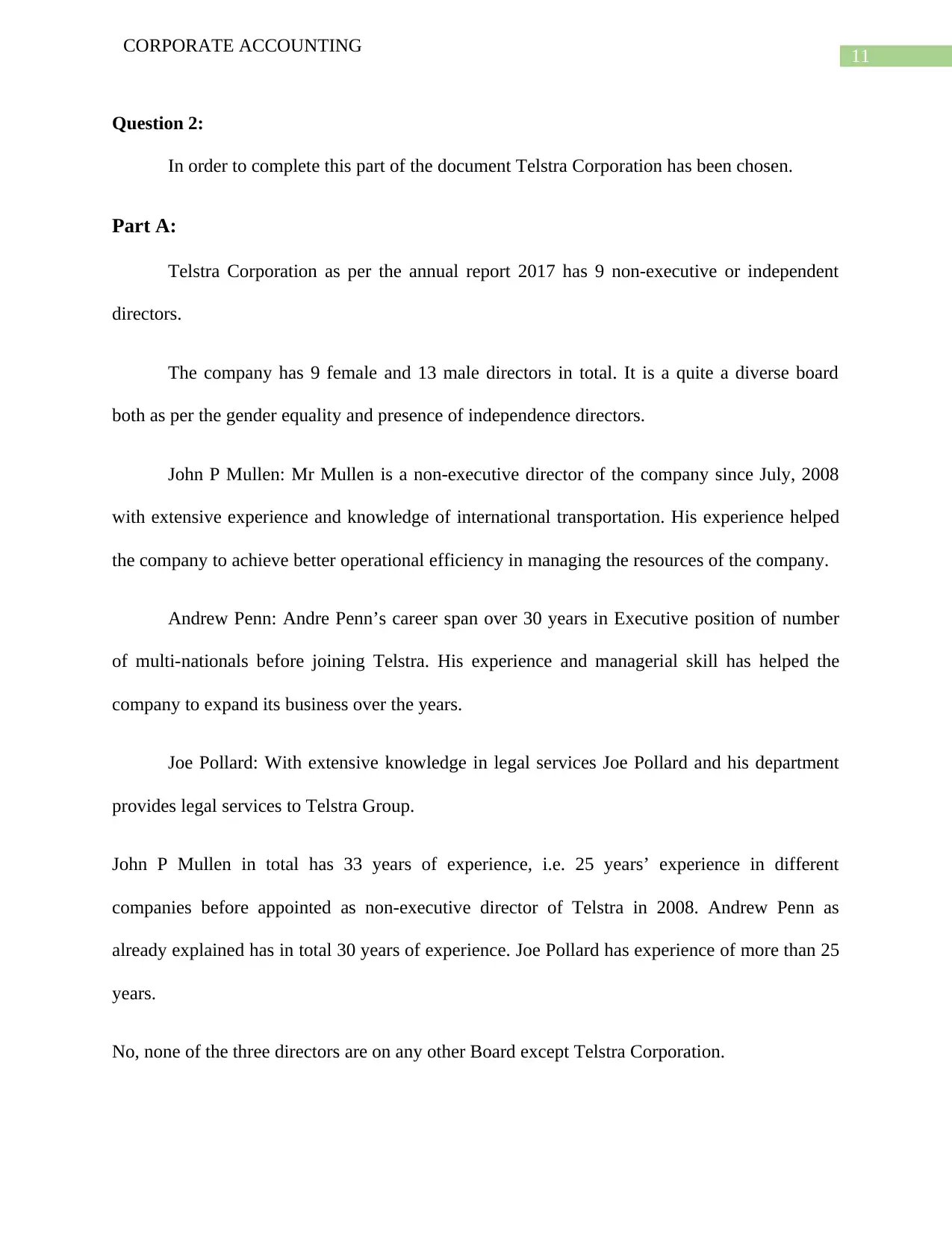
11
CORPORATE ACCOUNTING
Question 2:
In order to complete this part of the document Telstra Corporation has been chosen.
Part A:
Telstra Corporation as per the annual report 2017 has 9 non-executive or independent
directors.
The company has 9 female and 13 male directors in total. It is a quite a diverse board
both as per the gender equality and presence of independence directors.
John P Mullen: Mr Mullen is a non-executive director of the company since July, 2008
with extensive experience and knowledge of international transportation. His experience helped
the company to achieve better operational efficiency in managing the resources of the company.
Andrew Penn: Andre Penn’s career span over 30 years in Executive position of number
of multi-nationals before joining Telstra. His experience and managerial skill has helped the
company to expand its business over the years.
Joe Pollard: With extensive knowledge in legal services Joe Pollard and his department
provides legal services to Telstra Group.
John P Mullen in total has 33 years of experience, i.e. 25 years’ experience in different
companies before appointed as non-executive director of Telstra in 2008. Andrew Penn as
already explained has in total 30 years of experience. Joe Pollard has experience of more than 25
years.
No, none of the three directors are on any other Board except Telstra Corporation.
CORPORATE ACCOUNTING
Question 2:
In order to complete this part of the document Telstra Corporation has been chosen.
Part A:
Telstra Corporation as per the annual report 2017 has 9 non-executive or independent
directors.
The company has 9 female and 13 male directors in total. It is a quite a diverse board
both as per the gender equality and presence of independence directors.
John P Mullen: Mr Mullen is a non-executive director of the company since July, 2008
with extensive experience and knowledge of international transportation. His experience helped
the company to achieve better operational efficiency in managing the resources of the company.
Andrew Penn: Andre Penn’s career span over 30 years in Executive position of number
of multi-nationals before joining Telstra. His experience and managerial skill has helped the
company to expand its business over the years.
Joe Pollard: With extensive knowledge in legal services Joe Pollard and his department
provides legal services to Telstra Group.
John P Mullen in total has 33 years of experience, i.e. 25 years’ experience in different
companies before appointed as non-executive director of Telstra in 2008. Andrew Penn as
already explained has in total 30 years of experience. Joe Pollard has experience of more than 25
years.
No, none of the three directors are on any other Board except Telstra Corporation.
⊘ This is a preview!⊘
Do you want full access?
Subscribe today to unlock all pages.

Trusted by 1+ million students worldwide
1 out of 17
Related Documents
Your All-in-One AI-Powered Toolkit for Academic Success.
+13062052269
info@desklib.com
Available 24*7 on WhatsApp / Email
![[object Object]](/_next/static/media/star-bottom.7253800d.svg)
Unlock your academic potential
Copyright © 2020–2025 A2Z Services. All Rights Reserved. Developed and managed by ZUCOL.





